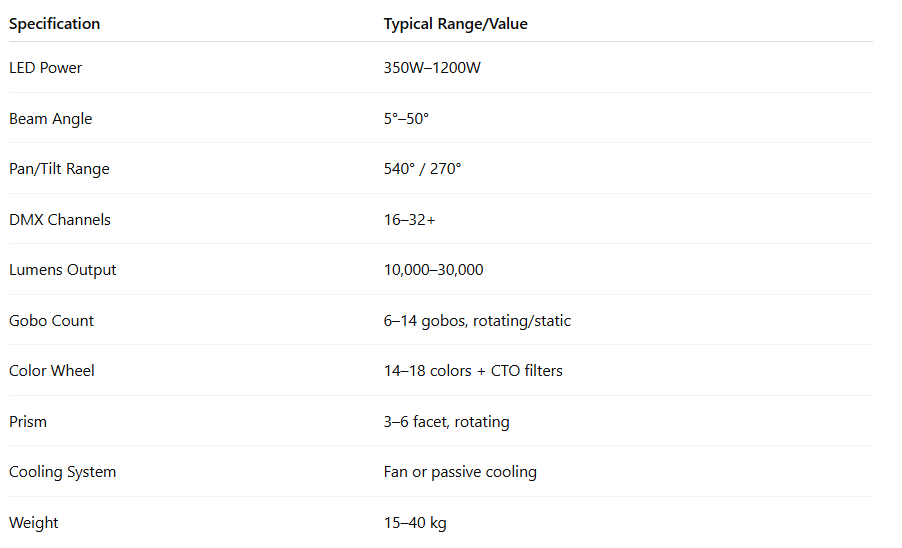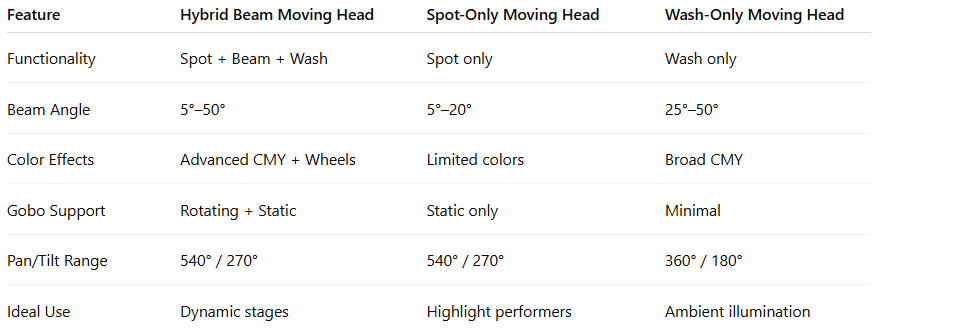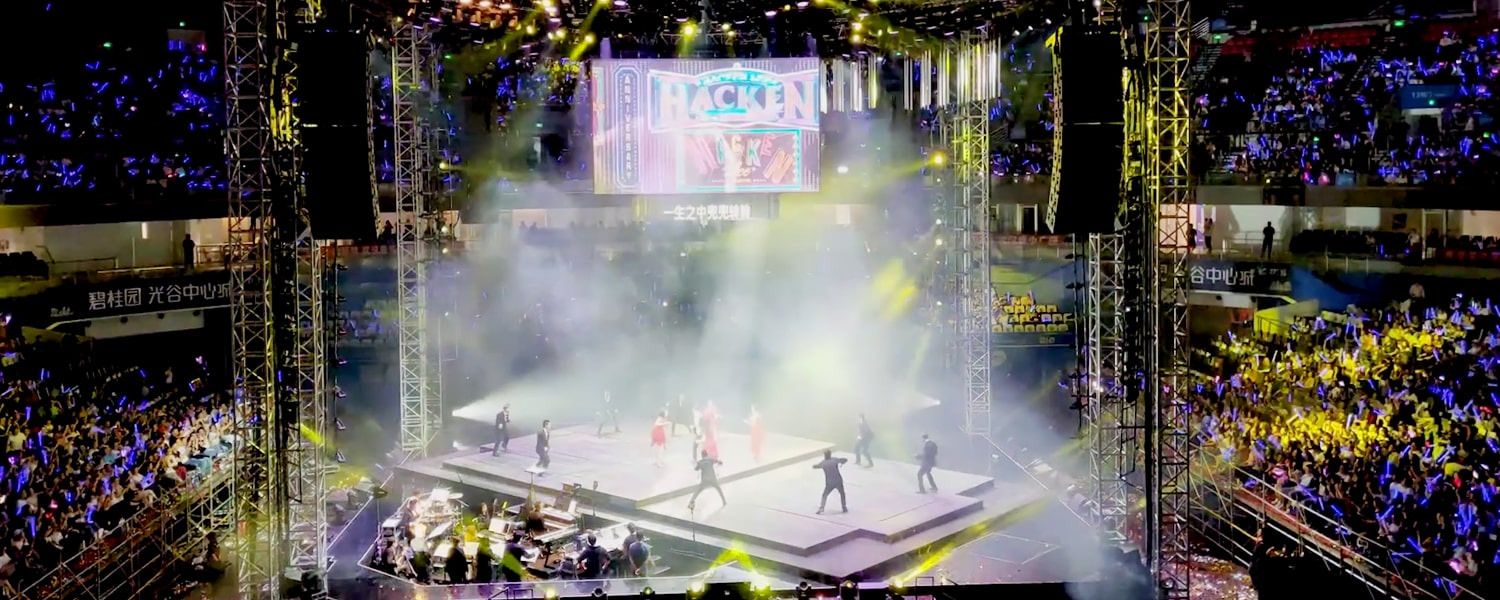A moving head beam is a cornerstone in modern stage lighting, offering precision, flexibility, and dynamic effects for concerts, theatrical performances, and large-scale events. Among the diverse family of moving head lights, the hybrid beam moving head light stands out for its unique capability to combine multiple lighting functions into a single fixture. Unlike traditional moving heads that serve a singular purpose—either a spot, wash, or beam—a hybrid model integrates all three functionalities. This versatility allows lighting designers to achieve complex visual effects while minimizing the number of fixtures required. By understanding the technical design, functionality, and applications of hybrid beam moving head lights, professionals and enthusiasts can optimize their lighting setups, achieving both aesthetic brilliance and operational efficiency.
In this article, we will explore the technical features, advantages, specifications, practical use cases, and best practices for hybrid beam moving head lights, providing an in-depth, user-focused guide for anyone working with modern stage lighting.
Understanding Hybrid Beam Moving Head Lights
Hybrid beam moving head lights are advanced lighting fixtures designed to combine the strengths of spot, wash, and beam lights into a single unit. This integration allows for dynamic lighting effects and versatility in diverse environments, from concerts to theaters to clubs.
Core Components and Technology
Light Source
Most hybrid beam lights utilize high-output LED sources, although some high-end models incorporate discharge lamps or lasers. LEDs provide energy efficiency, longer lifespan, and a wide color spectrum. Hybrid models often offer luminous flux between 10,000–30,000 lumens, depending on fixture size and lamp type.
Gobos
Gobos are templates inserted into the fixture to project patterns or shapes onto surfaces. Hybrid lights typically support rotating and static gobos, enabling designers to create dynamic visuals.
Prism Effects
A prism allows splitting the light into multiple beams or adding geometric patterns, enhancing the visual complexity. Prisms in hybrid beams often rotate or refract light dynamically, contributing to dramatic stage effects.
Color Wheel and Mixing
Hybrid beam lights include CMY color mixing and multiple dichroic filters, providing a broad palette of colors. This allows smooth transitions, gradient effects, and precise control over mood and ambiance.
Pan & Tilt Motors
Moving head lights employ servo or stepper motors to control horizontal (pan) and vertical (tilt) movements. Hybrid models typically feature 540° pan and 270° tilt capabilities, enabling sweeping stage coverage and complex motion patterns.
Hybrid Functionality
The term "hybrid" refers to the combination of spot, beam, and wash effects. Designers can switch modes, sometimes dynamically during a performance, without changing fixtures. This functionality reduces the need for multiple light types and streamlines stage setups.
Control System
Hybrid beam lights are fully compatible with DMX512 control protocols, allowing precise adjustments to beam angle, color, gobo rotation, zoom, prism effects, and motion patterns. Many fixtures also support RDM (Remote Device Management) for real-time status monitoring.
Beam Angle and Output
Hybrid beam moving heads typically offer adjustable beam angles from 5° (tight beam) to 50° (wash effect). Narrow angles produce sharp, high-intensity beams ideal for concert lighting or spotlighting performers. Wider angles create softer, diffused washes suitable for ambient illumination or covering large areas.
Real-World Example
Consider a concert with a large stage and dynamic performances. Using hybrid beam moving heads, a lighting designer can:
- Illuminate solo performers with sharp spot beams.
- Wash the stage in vibrant colors using the wash mode.
- Create moving beams and visual effects for audience engagement.
This versatility reduces equipment load while increasing visual impact.
Features and Benefits
Hybrid beam moving head lights offer several technical features that differentiate them from traditional fixtures:
Key Features
Adjustable Beam Angles and Zoom
- Zoom ranges often span 5°–50°, allowing designers to switch between narrow beams and wide washes.
- Continuous zoom ensures smooth transitions between effects.
Dynamic Color and Gobos
- Multi-color wheels with CMY mixing.
- Rotating and static gobos for pattern projection.
- Prism effects for complex geometric lighting.
Pan and Tilt Motion
- 540° pan and 270° tilt, enabling full stage coverage.
- Smooth and precise movements for synchronized effects.
High Output and Efficiency
- Luminous output ranging from 15,000–30,000 lumens.
- Energy-efficient LEDs, reducing power consumption.
Advanced Control Options
- DMX512 channels for intricate programming.
- Compatibility with lighting consoles and software for real-time control.
Benefits Over Traditional Fixtures
- Versatility: Combines spot, wash, and beam into one fixture.
- Space Efficiency: Reduces the number of fixtures needed for a stage.
- Operational Flexibility: Supports dynamic changes during performances.
- Energy Efficiency: Modern LEDs consume less power compared to conventional lamps.
Real-World Applications
- Concerts with rapidly changing lighting cues.
- Theater productions requiring both precise spotlights and ambient washes.
- Nightclubs needing dynamic beams for audience engagement.
Technical Specifications to Consider
When selecting a hybrid beam moving head light, consider the following technical specifications:

Safety and Handling
- Ensure proper rigging to support fixture weight.
- Allow adequate ventilation for heat dissipation.
- Follow DMX addressing protocols to prevent signal conflicts.
How to Use a Hybrid Beam Moving Head Light
Hybrid beam moving head lights require precise installation and programming for optimal performance.
Step 1: Installation
- Mount the fixture on a truss or lighting stand using proper clamps.
- Ensure safety cables are attached to prevent accidents.
- Connect power cables according to voltage specifications.
Step 2: DMX Addressing
- Assign DMX channels for pan, tilt, color, gobo, zoom, and intensity.
- Test communication using a DMX controller or lighting console.
- Verify fixture response to each channel.
Step 3: Programming Effects
- Use color mixing to set the desired palette.
- Select gobos and prism effects for dynamic patterns.
- Program movement sequences for synchronized stage effects.
Step 4: Real-Time Adjustments
- Adjust zoom and beam angle during performances.
- Switch between beam, spot, and wash modes as required.
- Monitor fixture temperature and ensure ventilation.
Troubleshooting
- DMX signal failure: Check cable continuity and channel assignments.
- Overheating: Ensure proper airflow and fan operation.
- Color or gobo misalignment: Inspect wheel installation and calibration.
Hybrid Beam vs Traditional Moving Head Lights

Hybrid moving heads excel in versatility, enabling lighting designers to reduce fixture count while delivering rich, layered effects.
Applications and Use Cases
Concerts and Music Festivals
- Provide dynamic beams and color washes for performers and audiences.
- Combine multiple hybrid fixtures for layered visual depth.
Theater Productions
- Highlight actors while maintaining ambient stage lighting.
- Create mood and scene transitions using color and gobo effects.
Clubs and Nightlife
- Produce high-impact, moving beams synchronized with music.
- Use prism effects and rotating gobos for immersive experiences.
Corporate Events
- Enhance product launches or presentations with controlled lighting effects.
- Reduce setup complexity by using hybrid lights instead of multiple fixture types.
FAQs
1. What is a hybrid moving head light used for?
Hybrid moving heads are used for dynamic stage lighting, combining spot, beam, and wash effects in one fixture for concerts, theater, and event production.
2. How is a hybrid beam different from a standard moving head beam?
A hybrid beam can function as a spot, wash, and beam simultaneously, whereas a standard moving head beam only produces a focused, narrow beam.
3. Can hybrid moving heads be DMX controlled?
Yes, they support DMX512 control protocols for precise adjustments to motion, color, gobos, zoom, and intensity.
4. What are common beam angles for hybrid lights?
Beam angles typically range from 5° (narrow beam) to 50° (wash mode), adjustable through the fixture’s zoom feature.
5. Are hybrid moving heads energy efficient?
Modern LED-based hybrid moving heads consume significantly less power than traditional discharge lamps while providing high lumen output.
6. How do I program hybrid beam effects for a concert?
Use a DMX lighting console to assign channels for pan, tilt, color, gobo, prism, and intensity. Pre-program sequences and test effects before the live event.
7. What safety precautions are needed?
Ensure proper mounting, attach safety cables, maintain ventilation, and follow electrical specifications for voltage and current.
Conclusion
Hybrid beam moving head lights represent a revolutionary step in modern stage lighting technology, offering unparalleled versatility and dynamic visual effects. By integrating spot, beam, and wash functionalities, these fixtures allow lighting designers to streamline setups, reduce equipment, and create immersive experiences. Understanding their technical specifications, control options, and proper usage is crucial for maximizing their potential in concerts, theaters, clubs, and corporate events. With careful planning, precise programming, and adherence to safety protocols, hybrid beam moving head lights can transform any stage into a visually stunning and technically efficient environment.

